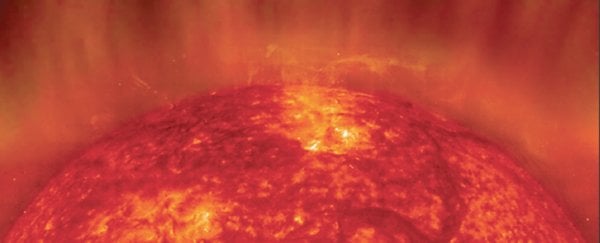
The company announced that a powerful geomagnetic storm had destroyed 40 Starlink satellites launched by SpaceX last week.
Elon Musk's company launched a 49-satellite Falcon 9 rocket from the Kennedy Space Center in Florida on Thursday (Feb. 3), but a geomagnetic storm hit the satellites a day later and caused the satellites to fall back to Earth, where they would burn up in the atmosphere.
"Unfortunately, the satellite deployed on Thursday was severely affected by the geomagnetic storm on Friday," SpaceX said in a statement.
"Preliminary analysis suggests that increased resistance at low altitude prevents satellites from leaving safe mode to begin orbital lift maneuvers, and up to 40 satellites will re-enter or have re-entered the Earth's atmosphere."
Related: The 12 strangest objects in the universe
A geomagnetic storm occurs when a solar wind - charged particles from the sun - hits the Earth's magnetic field and produces charged particles and electric currents in the Earth's upper atmosphere.
Surges warm the upper atmosphere and increase its atmospheric density, so satellites in low-Earth orbit experience enough drag to send them back to Earth. The geomagnetic storm experienced by the satellites came from the Coronal Mass Ejection of January 30 — the solar wind triggered by the solar eruption.
After launch, 49 SpaceX satellites began operating nearly 130 miles (210 kilometers) from Earth. Such low orbits are designed to make satellites easy to dispose of in the event of a failure after launch, but low orbits also make them vulnerable to geomagnetic storms.
SpaceX said in a statement that the satellite's GPS system showed that the atmospheric drag caused by the storm was "50 percent more than previous launches." In response, the satellite was ordered to "dodge the storm" by "flying at the edge (like a piece of paper)."
By reducing the surface area of the satellite through the atmosphere, this "edge" positioning is designed to prevent the satellite from decelerating rapidly.
But the resistance was too great. Forty satellites will now fall back to Earth. SpaceX assured the public that because the company's satellites are designed to disintegrate on re-entry, "no orbital debris will be generated and satellite parts will not hit the ground."
Since the launch of the first Starlink satellite in 2019, SpaceX has put 2,000 of these satellites into Earth orbit, and the company plans to place up to 42,000 satellites into earth orbit giant constellations.
Starlink plans to offer high-speed internet service to customers around the world, but it has been criticized by astronomers for its shiny satellites that often leave bright streaks in the night sky, disrupting astronomical observations.
A 2021 study showed that the 9,300 tons (8,440 metric tons) of space objects currently orbiting Earth, including non-working satellites and large used rocket stages, have increased the overall brightness of the night sky by more than 10 percent, contaminating much of the planet with light pollution, Live Science has previously reported.
Critics also say the SpaceX satellites clog low-Earth orbit slots that other companies or countries can use.
According to Live Science's sister website Space.com, space experts have even warned that once the first 12,000 satellites of Starlink's first-generation constellation enter orbit, they could lead to up to 90 percent of attempted accidents between two spacecraft in low-Earth orbit.
In December 2021, European Space Agency Director-General Josef Aschbacher said Musk was "making rules" in space, and he called on the EU and other countries to coordinate so that SpaceX's satellites would not prevent others from launching their satellites.